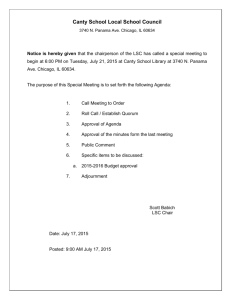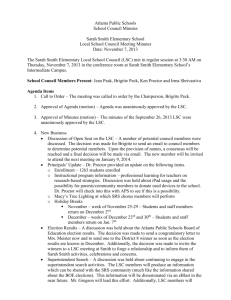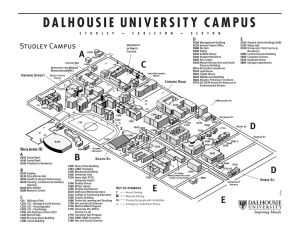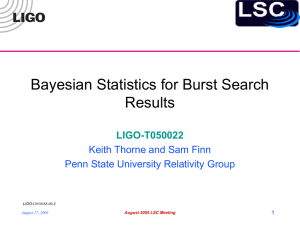i3J.--- J/,.M.J t~&r's signature)~ by
advertisement
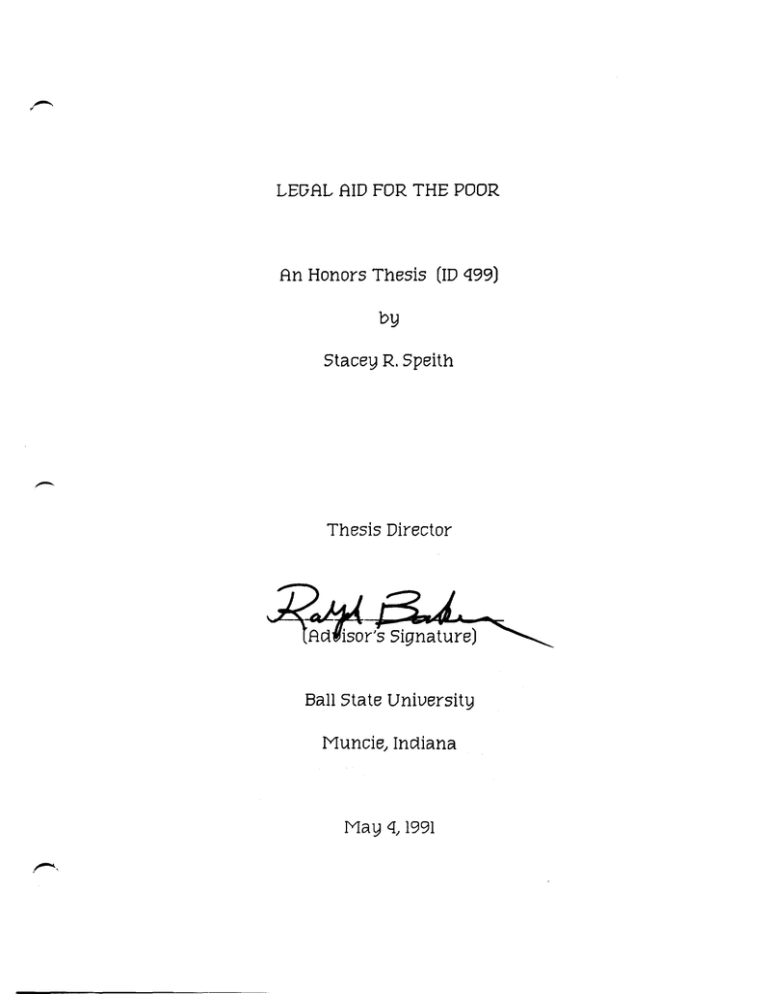
LE(l.AL .AID FOR THE POOR .An Honors Thesis (ID (199) by Stacey R. Speith Thesis Director J/,.M.J i3J.--- t~&r's signature)~ Ball State University Muncie} Indiana May <1} 1991 Sf'L'cl l 7Iie~.;5 rI -(./ ,..' II 0 c: LED FlL FlID FOR THE POOR: OUTLINE I. Introduction Fl. Low-income clients do not have the same legal remedies that are available to the poor. B. Counsel is provided for criminal cases but what about civil cases? C. Only 17.7 percent of private attorneys do pro bono work. D. 60 percent of the legal needs of the poor go unattended. II. Defects of the Justice System. Fl. Delays 1. People often do not bring suits because of the time it takes to reach a final judgmen t. 2. Undue delays may force unfair settlements and com promises. B. Court Costs and Fees. 1. Costs are a product of statutes. 2. Costs are too low to deter the rich but high enough to prohibit the poor. 3. Rules requiring security for costs have been upheld despite their harshness to the poor. C. Expense of Counsel. 1. Expense of counsel is a fundamental difficulty in the justice system. 2. Laymen need the assistance of counsel to understand the rules of law. III. Legal Services Corporation. Fl. Formation. 1. Enacted on July 25 197Q. 2. Purpose. 3. Make-up. a. Board of Directors. b. Bipartisan. c. Chairman. 1 -- B. Description. 1. The L5C is an independent organization that channels federal funds to legal aid lawyers for the poor in civil dispu tes. 2. What kind of cases does it handle? a. Divorce. b. Child-custody. c. Landlord-tenant. d. Employment/wage disputes. e. Personal injury. f. Property rights. g. Denial of Dovt. benefits. 3. Who does the L5C help? a. Two-thirds of the legal aid clients are women. b. Low-income families. c. The elderly. - IV. Examples. A. A 7D-year old woman had an eviction notice brought against her for failure to pay an unfair bill issued to her by her landlord. B. A 6Q-year old terminally ill woman received an eviction notice as a default judgmen t when she was not even aware that a hearing was to take place. V. End Legal-Bid Program for Poor? - L5C Pro and Con Debate. A. Edwin Meese III" counselor to ex-Pres. Reagan - Yes. 1. The L5C is not the best way to deliver legal services. 2. Criminal v. Civil rights to counsel. 3. Need greater involvement of the legal profession. Q. Need to utilize law school clinical programs. 5. Local bar has duty to provide legal services to the poor. 6. Use public funds to stimulate new" innovative programs. B. Archibald Cox" professor at Harvard Law School - No. 1. The L5C served 1112 million clients in 199D. 2. The L5C is a cost-effective operation - less than 2 percent of its funds go towards overhead. 3. The poor out to be equally represented in pressing their q. S. 6. 7. - interests. The LSC provides much needed help with cases such as: a. Class action suits - two-tenths of 1 percent. b. Family problems - thirty percent. c. Housing problems - 17 percent. d. Rights to welfare - 17 percent. The poor are uniquely dependent upon govt. money and services and should be able to obtain relief from them. The States were not providing the necessary legal services to the poor so the federal program was imperative. Private attorneys cannot do it alone. VI. The LSC and the Reagan Years. A. The LSC was the most hated social program by Reagan. B. Reagan believed that the LSC is misused by ultraliberals. C. Reagan deliberately appointed an interim eleven-member board of directors who are basically opposed to what the LSC does. D. Budget cuts have caused a drastic decrease in office staffs and caused many offices to close. VII. Alternative Programs to the LSC. A. Legal Aid Society of New York. 1. Criminal division. 2. Ci viI division. B. Atlanta Legal Aid Society provides instructional videotapes to its clien ts. C. Mandatory pro bono work required by attorneys. D. Los Angeles firm pays its attorneys for doing pro bono work. E. A NYC firm established a $10 million legal fellowship program. VIII. Conclusion. -- Since the establishment of the United States over two hundred years ago" freedom and the equality of justice have been the foundation upon which our entire plan for the administration of justice has been built. The A.merican colonists rebelled against the tyrannical and arbitrary conduct of King veorge III of England. A.fter winning their independence" their first law-making attempt declared that justice must be equal and accessible to all. This principal was not an utopian idea" but an indispensable safeguard of their hard won freedom (Smith 1971:11). Today" nearly every State Constitution" by -- express provision of the Bill of Rights" guarantees the freedom and equality of justice to all citizens. Vet still today" the system is not equal. The United States Supreme Court has guaranteed an attorney" at the government's expense if necessary" to every criminal defendant who faces a prison sentence. However in civil cases" which includes everything from custody proceedings to deportation hearings" the poor must rely on the generosity of others if they wish to enlist the aid of legal counsel. Low-income people just don't have the same legal remedies that are available to the rich (Quinn 1962:70). With only 17.7 6. _ percent of private attorneys performing pro bono, free legal, work, it is estimated that 60 percent of the legal needs of the poor go unattended (Lacayo 1966:59). Is that equality of justice? Most would agree that it , is not. The justice system has many defects inherent to its organization. The first defect is delay. The length of time from the initial establishment of a suit to its final judgment can be months or even years. Congested court dockets, investigatory procedures and postponements all bring about possible delays in the adjudication of court cases. The inevitability of delays may result in a person refraining from filing a suit. The necessary time commitments involved in a legal suit are conferences with attorneys, investigation procedures, compiling data, talking to witnesses, initial hearings, interrogatories, the sending and waiting for replies from both parties' attorneys, postponements, the time required for the actual trial, and the time needed for appeals. These all result in valuable time being taken away from a person's work and social activities. .A person may therefore be unwilling to initiate a suit in light of these time considerations. Even someone who initiates a law suit may be forced 7. - to make an untair settlement or compromise due to the amount ot delays involved. The second detect ot the justice system is court costs and fees. Court costs are not established by the constitution, they are not the product ot common law, they exists solely and entirely as creatures of statutes (Smith 1971:20). Fees are charged tor tiling a claim, the court time used, the documentation needed, witness tees, jury tees, transcript tees, etc. Although the costs may not be exorbitant for most, they can be high enough to prohibit the poor trom tiling a suit. The tees are not high enough to deter the rich trom petty suits, however (Smith 1971:2~). Courts have routinely upheld rules requiring security for costs, despite their patent harshness to the poor. The third detect of the justice system is the expense ot counsel. Expense ot counsel is a tundamental barrier because the attorney is an integral component in the administration ot justice. With the vast body ot ever changing law it is apparent that the layman, in order to understand his rights, must have the assistance ot counsel. Statutes and case lau' are constantly changing. Even attorneys must continually refer to codes and cases in evaluating the status of an S. - issue. Cases and statutes are not written for the layman to understand. Most are written by attorneys in a language that only attorneys can fully comprehend. Two possible explanations for this are: the fact that attorneys who write statutes and case opinions write merely within their own vocabulary. . or secondly. . that they write in a manner that necessarily requires an attorney to comprehend" thereby creating a constant need for the services of attorneys. Regardless of the motive. . the end result is the same ... the consultation of an attorney for even simple cases is indispensable. i What then are the alternatives for the poor? The Legal Services Corporation Act was enacted on July 2S. . 197Q in order to amend the Economic Opportunity Act of 195Q by transferring its legal services program to the Legal Services Corpora tion (LSC). The purpose of the L5C is to provide equal access of high quality legal services to those who otherwise could not afford adequate legal counsel. The Corporation has a board of directors made up of eleven voting members appointed by the President. . with the approval of the Senate. No more than six members may be of the same political 9. - party. A chairman is elected by the voting members of the Board" following the first initial appointment of a chairman by the President. The corporation is authorized to provide financial assistance to qualified programs furnishing legal assistance to eligible clients. Eligibility is determined by income level" liquid assets" fixed debts" medical expenses" cost of living" and any other factors which affect the client's ability to pay. Attorneys employed by the Corporation" or any of its affiliates" are required to carry out his professional responsibilities to his clients as established in the Canons of Ethics and the Code of Professional Responsibility of the American Bar Association. Accounts of the Corporation are sUbject to annual audits and reports are sent to the veneral Accounting Office" to Congress" and to the President. The Legal Services Corporation Act of 197q is subject to amendment., alteration" or repeal (q2 USC 2996). The Legal Services Corporation is an independent organization that channels federal funds to legal aid lawyers for the poor in civil disputes. In 1982" the LSC provided 85 percent of the money that supported local legal aid offices (Toufexis 1982:Q8). In 1981" the legal aid docket consisted of: ~O percent of its cases involving family law" 10. - mainly divorce and child custody; 16 percent of the cases involving income maintenance, helping clients get welfare and social security benefits that had been illegally denied to them; and lq percent of the cases involving consumer finance. Only IS percent of legal-aid cases go to court. Out of those cases 60-65 percent are won (Quinn 1962:70). The majority of the cases handled by the Legal Services Corporation involve divorce, child custody, landlord-tenant employment/wage disputes, personal injury, property rights, and the denial of government benefits suits. The LSC's principal clients are low-income families and the elderly, with two-thirds of these being women. Their clients are people who otherwise would have little or no chance for obtaining a legal remedy to a problem. Despite the sporadic success of some legal aid clinics, legal aid to the poor is still limited. The workload at legal aid offices is too tremendous to handle many divorce, child custody, landlord-tenant disputes, and their famous class-action suits (Serri11 1963:63). Legal aid clinics do not have the staff nor the money to handle their overburdened case load. Part of the problem is due to the lack of a ttorneys willing to offer their time pro bono, from the La tin term 11. - publico or "'for the public good" (Lacayo 1966:59). Also a major contributor to the lack of adequate services to indigent clients is the steady decrease in government funding for legal aid programs. Two examples of the need for legal aid for poor clients are the following. A seventy year-old widow was presented with a lumpsum bill from her landlord for $'1, DOD. The landlord had discovered that for seven years he had been charging his tenant less than he could have under New York City's complicated rent-control program" so he decided to collect on "'back rent." When she was unable to pay the bill he brought eviction proceedings against her, even though she had always paid the monthly rent she was charged. A second case involved a sixty-four year-old terminally ill woman who received a 72-hour eviction notice after a proceeding against her had been completed. She had no knowledge of the law suit; therefore, she had not opposed it. A default jUdgment was issued against her. The issue was non-payment of rent, which the client had no money to pay (Lamb 1967:15). The Legal Aid 50ciety of New York handled both of these cases and brought satisfactory outcomes. Where would these women have been without the aid of legal council? Most likely they 12. - would have ended up on the street or in a welfare hotel. In 1981., U.s. News and World Report published an interview/ debate between Edwin Meese III" counselor to President Reagan" and Archibald Cox" professor at Harvard Law School. The issue at question was: Whether or not legal aid programs for the poor should be ended? The following paragraphs include highlights of this article. Edwin Meese's opinion was that legal aid programs" specifically the Legal Services Corporation" should be ended. Meese stated that the LSC was not the most effective way of delivering legal services to the poor. Meese emphasized the differences between criminal and ci vil cases. He agreed that when a person was threatened with the loss of life or liberty that legal counsel should be provided to the indigent defendant. However" in civil cases the economic factors should be considered. The worthiness of a case should be determined by economic consequences. Meese called for greater involvement in the legal profession in dealing with legal aid cases. He also urged the utilization of law school clinical programs in which practicing members of the bar would supervise senior law school students in this work. Meese 13. - claimed that the LSC" "'stifles innovation" relies too heavily on a limited number of attorneys" and has virtually resulted in the legal profession turning its back on providing legal services to the poor." Meese ended by saying" "'The Reagan administration is in favor of providing legal serviced to everyone but does not feel that the LSC is the best method [to be used]." A.rchibald Cox advocated maintaining legal aid for the poor. In 1980 alone" the LSC served 11/2 million clients. The LSC is a costeffective operation with less than 2 percent of its funds going towards overhead. Cox affirmed that the poor ought to be equally represented in pressing their interests" The LSC provided much needed help with cases such as: class-action suits" two-tenths of 1 percent; family problems" ;:)0 percent; housing problems" 17 percent; and rights to welfare" 17 perceqt. Cox stated that the poor are uniquely dependent upon government money and services and should be able to obtain relief from them. The States were not prOViding the necessary legal services to the poor and private attorneys cannot do the job alone so the federal program was imperative. Without the LSC many people IQ. - would have no where to turn to for legal relief. The Legal Services Corporation has been been classified as the most hated social program by former President Reagan. The LSC helps fund about three-fourths of the legal aid operations around the country. Reagan went into office vowing to shut it down entirely. In 19B2" it lost a quarter of its budget which resulted in the closing of 2BB offices" a ;'0 percent reduction in its staff" and the turning away of thousands of needy individuals (Quinn 19B2:70). Reagan believed that the LSC was misused by ultra-liberal lawyers and so undercut its - effectiveness by appointing an interim eleven-member board of directors" most of whom were basically opposed to what the LSC does (Toufexis 19B2:'1B). One director came from a savings and loan association that was being sued by legal aid in California for alleged improper foreclosures. Several others have opposed legal aid in court. Reagan "'deliberately [put] people in charge of the LSC who were antipathetic to its purposes" (Quinn 19B2:70). The Reagan administration succeeded in crippling many LSC operations and made its future uncertain. 15. - There are several alternative programs to the Legal Services Corporation. The Legal Aid Society of New York is one of them. The Legal Aid Society (LAS) is the largest criminal-defense law firm in the world. It contains two divisions: the criminal division and the civil division (Pileggi 1992:30). In 1991, the LAS Civil Division represented approximately 20,000 low-income clients in civil cases on a budget of $Q.5 million, more than two-thirds of which were privately donated (pileggi 1992:32). The Atlanta Legal Aid Society provides qS minute instructional videotapes to its clients. These tapes show clients how to handle dispossessions, how to negotiate with landlords, and how to handle simple court matter by themselves. Although these tapes are not a replacement for the expertise of an attorney, they are helpful in simple cases that may not require the assistance of formal legal counsel (Toufexis 1992:Q9). Leaders of the bar in some States are trying to make it mandatory for attorneys to devote a fixed number of hours per year in support of representation to the poor or otherwise make a donation to a fund which provides legal services to the poor. A mandatory pro 15. - bono system would weigh hard on solo practitioners and small firms, however, It could also lead to inadequate representation by advocates who lack conviction or the specific legal skills necessary to help their poor clients. An example would be a divorce attorney trying to help a farm worker who was poisoned by pesticides (Lacayo 1966:59). Some law firms such as the Los Angeles firm, Lathon and Watkins, pays its attorneys to do pro bono work within the community. A New York City megafirm, Skadden, Arps, State, Meagher, and Flom, established a $10 million legal fellowship program to place 125 new law school graduates with legal aid groups around the country over a five year period. "This is a demonstration that large firms are concerned about the public interests/, said executive partner Pete Mullen (Lacayo 1966:59). Equal Justice should not be an utopian idea. The denial of Justice to the poor is the short cut to anarchy. When people feel that they are not adequately protected by the administrative system, they have nothing to lose by working outside of that system. The Legal Services Corporation provides a necessary service, delivering legal remedies to those who would otherwise be without. However, the LSC cannot 17. - work alone. A.lternative programs, like those mentioned above, need to be established to work in conjunction with the LSC and the State to provide legal aid to indigent clients. In a statement made before the Virginia Bar A.ssociation ex-President William Taft had this to say, "'We must make it so that the poor man will have nearly as possible an equal opportunity in litigating as the rich man, and under present conditions, ashamed as we may be of it, this is not the fact .. (Smith 1971:5). I believe that it is a timely statement that is true of today's system of justice. Steps must be taken to insure the equality of justice for all people" regardless of their ability to pay. The Legal Services Corporation is a positive step in the direction towards the equality of justice. 18. WORKS CITED "'End Legal-Aid Program for Poor? - Pro and Con:" US, News and World Report. Rug 1961: ~~-~<:1, Lacayo, Richard, "The Sad Fate of Legal Rid," Time, 20 June 1966: 59, Lam b, James R, Jr, NMy Son, the Do-vooder," Newsweek, 16 Nov, 1967: 1<:1-15, Pileggt Nicholas, "'The Last Liberals," New Vork, 1962: 26-~5, 1~ Sept. Quinn, Jane Bryant. Justice for the Poor," Newsweek, 12 Rpril 1962: 70, N Serrilt Michael S, "'Rn Organization at War with Itself," Time, ~ Oct. 196~: 6~, 5mith, Reginald Heber, Justice and the poor, Ed, David J, Rothman, New Vork: Rrno Press and The New Vork Times" 1971. Toufexis, Rnastasia, "'The Return of Unequal Justice?" Time, 27 Dec, 1962: <:16, <:12 US, Code 2996, Public Law July 25, 197<:1, 9~-~55, 9~rd Congress, H,R, 762<:1,


